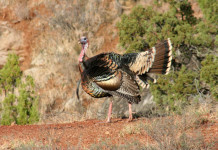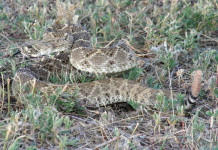Sadie’s stubby, liver-colored tail wiggled with feverish excitement as she bounded from the dog box in the back of the Suburban.
A hundred yards away, another more sinister tail was laying in wait.
Our year-old German shorthair pup exhibited the usual tendencies that a squirming toddler would, inspecting every nook and cranny of her new surroundings and having a whale of a time relishing all the subtle nuances. There were basketball-size shocks of bunchgrass that held at least one small covey of bobwhites and two more jackrabbits that were sent scurrying by a prying nose and prancing paws. Every bounding stride seemed to bring more dazzling sights and sounds to the wide-eyed pup, and after she tired of frantically sending grasshoppers fluttering skyward, it was time to get down to business at the bird dog club lease.
She had to track down the real quarry she was here to locate.
Fitted with a thicker collar than usual attached to a lead line, Sadie was passed off to a veteran West Texas dog trainer who proceeded to walk her over to an undisturbed clump of shinery that had a special surprise she never had laid eyes on or caught a whiff of. Nosing curiously up to the clump of brush, Sadie peeked in to see what odd creature was making such a ruckus and got a jolt.
However, the charge that sent her reeling skyward wasn’t a bite from the peeved 4-foot western diamondback rattler that remained coiled securely in a menacing ball of muscle, the only clue to its authenticity the pulsating rattles resonating near and far. The real culprit was the electronic training collar draped around her neck, the device registering enough of an impact to make the dog think that the bad boy in the bushes was what actually dished out the harm.
The trainer helped calm Sadie down and allowed her to regain her composure after what had been a trying few seconds. Typically, it only takes one good dose of electric current to hammer the point home that snakes — the mere sight or smell of them are bad — but just for good measure the trainer led Sadie over to a different concealed rattler and doled out a repeat lesson. After calming her down the second time, Sadie wouldn’t even look at the first snake, much less go near it when led by, keeping at least 10 feet clear of the alarming animal.
Lesson learned.
“Snake-proofing” is the easiest and most successful way to keep a dog’s nose out of places it shouldn’t be, specifically clear of critters that can leave more than just a mark, and it’s great insurance to not only keep your pooch healthy and hunting but also to help avoid large costs associated with anti-venom treatments.
Most bird dog clubs across the state offer snake-proofing clinics at some point during the year, while bird dog breeders and trainers often offer the service multiple times during snake season, including in the spring when serpents first become fully active and into the fall when hunting dogs are set to hit the field.
However, the lessons learned in these settings don’t just apply to hunting breeds, and more often than not if you attend a snake-proofing seminar you’ll see house dogs of all shapes and sizes, and for good measure. Any canine living in our state is susceptible to the four basic categories of venomous snakes: coral snakes, copperheads, cottonmouths and most of all rattlesnakes, specifically the western diamondback. The western diamondback’s range includes all of the state except for the eastern portion of the Pineywoods and the northern edge of the Panhandle, making it the No. 1 threat to our canine companions for a solid eight to nine months of the year.
While snake-proofing is one form of great insurance for your dogs, another comes in the form of a vaccine developed and approved for nationwide use in 2004 by Woodland, Calif.-based biomedical company Red Rock Biologics. Red Rock’s rattlesnake vaccine specifically was developed to combat the effect of western diamondback venom, which has a huge range in the southwestern United States, including Arizona and California.
However, the vaccine also has shown success in buying time for dogs bitten by other venomous snakes, a fate that even a decade ago meant almost certain death if a canine was hit with a hot dose of venom with no immediate medical help available.
Marty Janway of Red Rock Biologics said that the company’s vaccine success has been bevied by a need for preventative care by a growing segment of dog owners.
She said that the vaccine developed to reduce pain, swelling and tissue damage in the event of western diamondback envenomations also works well in dealing with bites from snakes that dole out similar toxins.
“As far as our target niche, it’s basically any dog that lives, works, plays or hunts in any areas where they’re going to be exposed to rattlesnakes or copperheads,” she said. “It works well with most of the rattlesnakes in the U.S. It also works well with copperheads. There’s a few snakes it doesn’t work well with. It doesn’t work against coral snakes at all. It does not work against the water moccasin. It also is poor against the eastern diamondback, it does help a little tiny bit, but not very much.”
Janway said there are more than 4,000 clinics nationwide that carry the vaccine, including more than 1,000 in Texas.
“The vaccine stimulates the dog to produce its own antibodies so he has the equivalent of two to three vials of anti-venom on board at the time of a bite,” she said. “The antibodies last about six months so depending on what your snake season is will depend on how often you booster. In Texas, we would just recommend that you guys just do a standard booster every six months. And ideally you need to start it at least 60 days before a dog would be exposed because depending on the size of the dog it takes 60 to 90 days — it’s 30 days after their last shot is when they have their maximum immunity.”
Considering that anti-venom treatments can run hundreds of dollars per vial and even then aren’t always readily available in some locales, the price charged per vaccine from a licensed veterinarian is well worth the minor expense. The vaccine only is available through licensed vets, and most charge between $20 and $30 for each dose.
Hidden dangers come with the territory for hunting dogs and other canines, but thanks to a pair of preventative measures, the lurking anxiety loses most of its bite.
In the case of electronic collar training, it sure beats the alternative jolt.





















Read your article.
I live in Houston and have a year old yellow lab. I also have a weekend property on the Blanco River in San Marcos.
Do you know of any snake aversion training in either cities?
I’m looking for a rattlesnake avoidance trainer for my young Lab puppy near SEGUIN, Tx